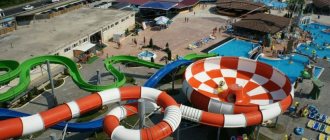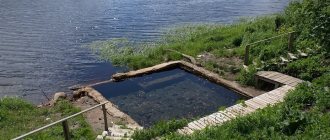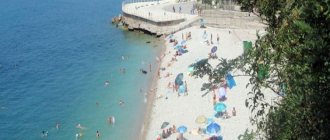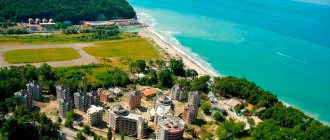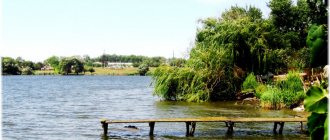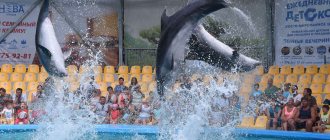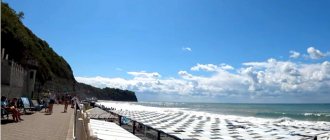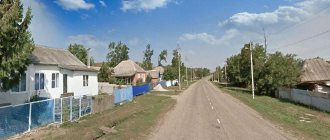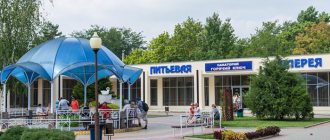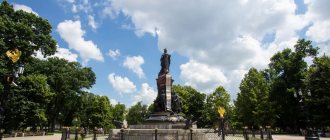The history of the most popular Crimean resort, Yalta, went through almost all the same milestone periods that befell the entire peninsula, especially its Black Sea coast.
The first settlements of the Tauri
, dating back to the 6th-5th centuries BC, were discovered by archaeologists in the city.
But the city of Yalta itself was created by the Greeks
, as local legend says.
The popular Crimean resort of Yalta has a very rich history
History of Yalta
Carefree and romantic Yalta.
It’s hard to even imagine how much this city had to endure during its existence. Its history is a series of ups and downs, periods of oblivion and world fame. The first official mention of Yalta dates back to 1154, when it appeared in the works of the Arab geographer and traveler Al-Idrisi as the town of Jalita. However, the results of excavations show that a settlement existed on this site much earlier, some of the finds date back to the 1st century BC. In any case, at the beginning of its “official” history, Yalta was considered a rich settlement. In the 13th century, Venetian merchants and Genoese traded here, alternately pushing each other out, until the Turks replaced them in 1475. During the Ottoman Empire, Yalta did not shine, but at the same time it was part of a province that belonged to the Sultan himself. By 1771, when Crimea was captured by Russian troops under the command of A.V. Suvorov, Yalta was just a small fishing village of 13 households, which, surprisingly, had a church and a mosque. Everything changed dramatically in 1823, when Novorossia, which then included the Crimean Peninsula, was headed by Governor General M.S. Vorontsov. Under him, Yalta received the status of a city, luxurious palaces began to appear in its surroundings, and two large wineries began operating at once, including the legendary Massandra plant.
Yalta embankment, August, boat trip
The years of the Crimean War, from 1854 to 1855, became a difficult time for Yalta. It was almost completely looted; there was no money to restore it. At that time, the city did not even have a port - arriving steamships stopped at the roadstead and were connected to the shore by longboats. Perhaps a slow death awaited Yalta, but in 1866 Professor S.P. Botkin discovered that the local climate was good for health and the Empress herself, Maria Alexandrovna, began to come here. In the 70s of the 19th century, construction in this area was carried out at an unprecedented pace. Neighboring Livadia was bought by the royal family. In Yalta itself, representatives of the aristocracy, wealthy manufacturers and merchants built mansions. It began to be called the Russian Riviera, compared with Naples and the resorts of the Cote d'Azur. In addition to rich people, creative intelligentsia also flocked to Yalta. Here, on the advice of doctors, A.P. Chekhov spent several years of his life; at different times, L.N. Tolstoy, S.Ya. Marshak, S.V. Rachmaninov, I.I. Levitan, S. A. Yesenin and many many others. Life at the aristocratic fashionable resort flowed calmly and measuredly, but at the beginning of the 20th century it was disrupted by the revolution. During the civil war, Yalta, albeit briefly, was renamed Krasnoarmeysk, and also gained worldwide fame due to the mass extermination of people. However, soon everything fell into place and already in 1921 people were vacationing here again. Only this time it’s not the aristocracy, but workers and peasants. It should be noted that in the future they were replaced by representatives of the party elite.
During the Great Patriotic War, Yalta received the wounded, local sanatoriums were converted into hospitals. In 1945, it thundered throughout the world - a meeting of the anti-Hitler coalition - Stalin, Cherrill and Roosevelt - was held at the Livadia Palace, at which issues related not only to the fate of our country, but also to the direction of world politics were resolved. The collapse of the Soviet Union went smoothly for Yalta. It continued to be a popular resort, only for our compatriots it became a foreign destination. In 2014, the Crimean Peninsula, and with it Yalta, again became part of Russia.
Recreation Alley on the Yalta Embankment
Population
In terms of population, Yalta ranks honorably third among all cities on the peninsula. About 90 thousand people permanently live in Yalta itself. Moreover, every holiday season this figure increases by 300,000 - 500,000 people due to city guests and tourists.
As for the gender and age group of the population, 45% are men, and 55% are representatives of the fair sex. It is noteworthy that in recent years the percentage of the population that is younger and older than working age has increased sharply. But the percentage of the working-age population is constantly decreasing.
If we talk about the demographic situation as a whole, it has almost the lowest indicators in Crimea. The average birth rate is 9.3 per 1000 people. The mortality rate exceeds these indicators by 2 times.
Residents of Yalta on May Day
Recently, the percentage of marriages has increased and divorce cases have decreased. It is interesting that Yalta residents get divorced least of all in the cities of Crimea.
If we talk about the education of city residents, there is no clear answer. There are not many higher educational institutions in the city, in particular only three: the Crimean Humanitarian University, the Institute of Economics and Management, and the European University. Mostly a variety of colleges and schools predominate. In general, education and its accessibility are at an average level.
The people here are friendly, friendly, accustomed to numerous tourists. They will tell you how to get there and how to get there. True, the traders at the markets are a little rude.
Districts
Visually, the city can be divided into 3 parts: - Chekhovo. A former village that was recently incorporated into the city. The village received its name in honor of A. P. Chekhov, who had a summer cottage in these parts; — New Yalta. A civilized, developed area of the city with high-rise buildings and all the necessary infrastructure; - Old Yalta. A cozy place with narrow streets and ancient houses from past centuries. At night, the place becomes an open-air entertainment event centered on the city's waterfront.
Climate
Yalta is a city with a temperate Mediterranean climate, ideal not only for relaxation, but also for the treatment of all kinds of diseases. In summer the city is warm, but not hot – the temperature stays around 26-30 degrees. The swimming season opens in mid-May and ends towards the end of October. Winter in Yalta is mild, but sometimes, albeit briefly, just for a few days, snow falls. On average, the temperature in January-February (these months are considered the coldest) is around plus 3-5 degrees. In mid-August, the popular velvet season in Yalta begins, when the sultry heat gradually turns into warm coolness, and the sea is still warm. Swimming during the velvet season is a pleasure.
Conclusion.
To summarize, I can say that Yalta is an amazing city. Yalta is good for its climate and nature, as well as its warm and gentle sea. For those who like to “hang out,” there are a lot of entertainment venues here, there is even a boat that goes out to sea at night and hosts a disco on it on the open sea.
If you have never been to Yalta before, be sure to visit it. There are a lot of interesting places that are worth seeing, especially the wonderful nature here, it will not leave you indifferent.
In this article I tried to tell as much as possible about Yalta what I learned after living in the city, perhaps I missed something. If you have anything to add to the article, leave comments. I will write about our travels around Yalta and its surroundings in the following articles, I hope that you will find it interesting and useful. Therefore, subscribe to blog updates and be the first to receive new articles!!!
Beaches of Yalta
The beaches of Yalta are known far beyond the resort. Some of them display the Blue Flag of the European Union, indicating that they truly meet all possible standards. There are pebbles almost everywhere; those who like to lie on the sand will be disappointed. The same goes for tourists who come with small children - the entry into the sea is quite abrupt, and the depth gains quickly. Therefore, you won’t have to take your eyes off the child. Most of the beaches are municipal, so entry will be free, but you will have to pay for all other amenities and services. There are also elite beaches with paid entrance - these are the territory of hotels or sanatoriums that have their own beach area. All beaches of Yalta are equipped with everything you need for a comfortable stay: sun loungers, umbrellas, changing rooms, showers, restrooms and other little things.
Golden Beach
Any vacationer in Yalta has heard about Golden Beach at least once - the legendary staircase leading to it “lit up” on Soviet-era postcards. However, its promising name is connected not with sand, as it might seem (like all the others, it is pebbly), but with history - once upon a time, entrepreneurs really sold small pebbles from this place “for the price of gold.”
The beach itself is very clean. It is relatively difficult to get to, so there are not many vacationers. The infrastructure is up to standard - there are sun loungers, umbrellas, changing cabins, and showers. In addition, there is a club-restaurant where you can always have lunch. At night it turns into a dance floor, where famous DJs play tracks. It is thanks to this that Golden Beach gained popularity among young people and even the status of “local Ibiza”.
If you believe local legends, the pebbles of the Golden Beach have healing properties - lying on them can get rid of many diseases. Whether this is true or not, one can only guess. But the fact that it is comfortable and pleasant to relax here, the strip is wide and there is enough space for everyone - we can say with confidence.
Yalta - “Golden Beach”
Masandra beach
Masandrovsky beach is one of the busiest in Yalta. The European Blue Flag flutters proudly above it, which indicates compliance not only with Russian, but also with world standards. The territory is conventionally divided into several zones (the cost of entry to each of them is different), three of which are endowed with VIP status. Here, in addition to the standard set of umbrellas and sun loungers, vacationers have access to unusual reed bungalows where they can hide from the sun.
Masandra beach boasts a huge amount of entertainment. During the day there are attractions here, there is a rental point for water equipment and equipment. Those who wish can have a massage, drink a cocktail in the bar or have a snack in the restaurant. There are also many “fashionable features”, so that guests do not get bored, the animators work, and sports competitions are constantly held. In the evening, the coast turns into a dance floor; sometimes concerts of famous stars are held here.
Massandra beach
Livadia beach
Livadia beach is one of the cleanest and most beautiful in Yalta. It is located in the vicinity of the palace of the same name, but getting to it is not so easy - the descent is very steep. For the convenience of vacationers, there are elevators, but the “fare” for them is quite high - 50 rubles.
The beach itself is not too big, its length is about 250 meters, but all infrastructure facilities are compactly located here: cafes, equipment rental points, changing cabins and showers. You can also rent a sunbed and umbrella.
Livadia beach differs from many others in that the pebbles here are not large and smooth. It is quite possible to walk on it barefoot without experiencing any particular inconvenience. In addition, despite the large number of vacationers, it is usually quiet and peaceful here. Perhaps the lack of animators is having an effect.
Nikitsky beach
The length is 250 meters, quiet and secluded, located near the botanical garden of the same name. It is not particularly popular among tourists. Firstly, it will take quite a long time to get here by bus from the center of Yalta. Secondly, the level of infrastructure leaves much to be desired - railings, umbrellas and sun loungers probably remember Soviet times, there are no showers (only changing cabins), there are few cafes and they cannot boast of a varied menu - they mainly offer fast food. But Nikitsky Beach also has its advantages. Firstly, in addition to the regular bus, you can get here in a completely unusual way - by boat. Secondly, this is simply an ideal place for those who do not like crowds of vacationers, intrusive entertainment, loud music and other delights of civilization. You definitely won’t have to “fight for a place in the sun” on Nikitsky Beach. And finally, a holiday by the sea can be combined with a visit to the legendary Botanical Garden. In general, the beach in Nikita is not for everybody, but it invariably finds its admirers.
Beach hotel Yalta-Intourist
The beach of the legendary Yalta-Intourist hotel is another one, awarded the honorary Pigeons by the flag of the European Union. Guests relax here for free; for other tourists there is an entrance fee.
As for the infrastructure, it is really up to par. There are umbrellas and sun loungers along the entire coastline; you can rent a trestle bed or an inflatable mattress. There are toilets, showers with hot water, and changing cabins. In addition, guests can enjoy a fitness center and a massage parlor. Sports competitions in volleyball, football and table tennis are constantly held. Those who like to tickle their nerves will certainly appreciate the area with attractions and the opportunity to go water skiing or aqua-bike. For children there is a mini-water park with slides and a small pool. Animators work efficiently, but unobtrusively.
In general, this beach, as well as the Yalta-Intourist hotel, are associated with high-class vacations. True, the prices here are appropriate.
Beach hotel Yalta-Intourist
How to get to Yalta
The path to sunny Yalta will pass through Simferopol, Anapa or Krasnodar. Trains and planes depart daily from major Russian cities to Simferopol. During the holiday season, bus tours to Simferopol are organized from major cities. If you go through Anapa or Krasnodar, then the end point will be the port of Kavkaz, then you will need to proceed by ferry or catamaran, which deliver tourists to the cultural capital of Crimea. There is public transport from Simferopol to Yalta, and you can also use the services of a taxi company. Getting from Simferopol to Yalta is not difficult. Despite the rather large distance between the cities, almost 80 kilometers, they are connected by a trolleybus line. Route No. 52 departs from the railway station (service interval is 15-20 minutes, ticket price is 87 rubles), and from the airport - No. 55 (service interval is 60 minutes, ticket price is 98 rubles). In both cases, the final stop is the Yalta bus station.
There are also buses and minibuses and buses that depart quite frequently. They have fewer stops, so the travel time is shorter than on a trolleybus. But the ticket costs more, about 120 rubles. Excursions in Yalta
General information
The city of Yalta is the administrative center of the urban district, which is called Greater Yalta. It consists of 32 settlements:
- 2 cities - Yalta, Alupka. - 21 urban-type settlements - Beregovoe, Vinogradnoye, Voskhod, Gaspra, Blue Bay, Gurzuf, Katsiveli, Koreiz, Krasnokamenka, Kurpaty, Livadia, Massandra, Nikita, Oreanda, Otradnoye, Parkovoye, Ponizovka, Sanatornoye, Simeiz, Sovetskoye, Foros. — 8 villages — Vysokogornoye, Gornoye, Danilovka, Kuibyshevo, Lineinoye, Oliva, Otradnoye, Partizanskoye. — 1 village — Opolznevoye.
Descriptions of almost all settlements are on our portal; on this page there is a description of the city of Yalta.
The city covers an area of 18 square kilometers. The permanent resident population is approximately 80,000 people; during the holiday season from May to October it increases to 500,000. The main nationalities are Russians, Ukrainians, Crimean Tatars, Belarusians, Jews, etc. Geographic coordinates 44°29′58″ N. w. 34°09′19″ E. d. City Day - the second Saturday of August. City telephone code: +7 3654. Telephone of the Yalta city administration (the “Current Call” telephone line is open from 09-00 to 16-00). Telephone number of the Department of Resorts and Tourism in the Yalta Administration: +7 (3654) 31-06-20. Administration email Distances from Yalta to cities: - Alupka - 21 km, - Alushta - 35 km, - Simferopol (via Alushta) - 81 km, - Bakhchisarai - 84 km, - Sevastopol - 85 km, - Sudak - 120 km, - Evpatoria - 160 km, - Feodosia (via Simferopol) - 170 km, - Kerch (via Simferopol) - 290 km, - Krasnodar - 530 km, - Rostov-on-Don - 770 km, - Moscow - 1900 km, - St. Petersburg - 2600 km, - Novosibirsk - 4500 km, - Khabarovsk - 9600km.
Excursions in Yalta
Yalta and its surroundings are rich in attractions, so inquisitive tourists will definitely not be bored. Local travel agencies offer both sightseeing tours, which include all the best (visits to the Livadia Palace, Vorontsov Palace, Swallow's Nest Castle, and so on), and more narrowly focused ones. For example, to the Massandra wine factory, to A.P.’s dacha. Chekhov and so on.
However, you should still start your acquaintance with a walking tour around the city itself. Here, of course, you can’t do without visiting the embankment, small churches, and cozy mansions preserved from the 19th century.
Yalta embankment
Hotels in Yalta
Yalta has a huge number of hotels, boarding houses, sanatoriums and holiday homes of different classes and price categories. They are like a reflection of the resort history of the city. Here you can stay in a luxurious mansion, in a Soviet “anthill”, or in a modern complex. When choosing where to stay, you need to take into account the location and distance from the sea - do not forget that Yalta is a city with a rather difficult terrain, so 500 meters can sometimes be quite a long distance for physically unprepared guests.
There are a huge number of accommodation options in sunny Yalta; everyone can choose housing according to their financial capabilities and criteria: - Boarding houses and sanatoriums. Here, under the supervision of professionals, you can perfectly improve your health and enjoy your holiday on the beach; — Hotels and inns. The number of rooms in this area is quite rich, you can choose the best option for yourself, which will exactly meet all your desires; — Guest houses and private sector. The most budget accommodation option in Crimea. There will be everything you need for a comfortable stay; - Apartments for rent. In Crimea there are a large number of private owners and agents who rent out apartments during the swimming season at affordable prices. The price per night for accommodation in Yalta depends on many factors: distance from the nearest beach, availability of amenities in the room, class of service, etc.
Four-star hotel complex Yalta-Intourist
It is considered the hallmark of Yalta, located in Masandrovsky Park, right on the seashore. Guests can enjoy luxurious rooms, a private beach with well-developed infrastructure, a small water park, swimming pools, restaurants, bars, and a spa center. For younger guests there is a play area, a zoo and even an aquarium. Yalta-Intourist also operates on the much-loved “all inclusive” system, being a good alternative to Turkey and Egypt that attracts many of our compatriots. Not long ago, new Green Park hotel buildings were opened. Web cameras of the Yalta-Intourist hotel allow you to monitor it in real time.
Yalta-Intourist.
Three star hotel Bristol
Located in the center of Yalta, this is a luxury hotel. The road to the public beach will take no more than 10 minutes; within walking distance are all the delights of the central part of the city - cafes, restaurants, attractions. Guests can also enjoy a private pool and a buffet breakfast served every morning in the restaurant, which is included in the room rate.
Mini-hotel Chaika
If we talk about small hotels, we should definitely mention the Chaika mini-hotel, consisting of only six rooms. In addition to cleanliness and a standard set of services, guests here will enjoy the comfort of home - a shared kitchen, a lounge area where guests socialize and have fun in the evenings, so that they don’t get bored, the animation team works, and a beautiful garden.
Apart-hotel Matrossky-5
If you want to rent an apartment, you can pay attention to the apart-hotel Matrossky-5, located in the central part of the city, right on the seashore. The windows of the apartment offer a breathtaking view, which will be an excellent addition to a good modern interior.
Tips for moving to the South of Russia
Before buying or renting real estate in the south of Russia for the purpose of moving for permanent residence, listen to the advice of people who already live there:
- Find out in advance what the climate is in the region. It is very important that it suits you. Not everyone can handle the sweltering heat or extreme humidity in winter. In some cities, gusty winds often occur, which greatly annoys local residents.
- Find out as much as possible about the property you are going to buy. There are many long-term construction projects in the south. For example, Kuban is among the leaders in the number of problematic new buildings. Another problem may be self-construction without the necessary documents for commissioning. The high-rise building may be declared illegal and a decision to demolish it may be made.
- study the job market. Will you be able to find work in the region? Is there a demand for your specialty? In some regions, there is a risk of being left without a job due to a lack of demand for the profession or a large competition for a position.
- find out if you can get a place in the kindergarten closest to your home or enroll your child in school. In some regions of southern Russia, schools and preschool institutions are overcrowded. Training is organized in two shifts; in Krasnodar and Sochi this is the rule in almost every school. In Crimea, there are huge queues for kindergarten.
- in the private sector there may be interruptions in water and electricity.
What to see in Yalta? — Sights of Yalta
In the 19th century, Yalta was considered an aristocratic resort, where the richest and most privileged officials of Imperial Russia vacationed. It is not surprising that at this time many luxurious palaces appeared on the coast. Next to them traditionally huddled much more modest dachas, which were a haven for the creative intelligentsia. And, of course, nature also contributed to the kaleidoscope of attractions. The result is a bright mosaic that attracts modern, inquisitive tourists. So, where to start getting acquainted with interesting and memorable places in Yalta? In sunny Yalta there are a large number of places that are definitely worth visiting for all vacationers: 1. Palaces and castles. On the territory of Yalta and its immediate surroundings there are a large number of palaces, each of which is unique and inimitable in its own way: Swallow's Nest, Dulber Palace, Gaspra Palace, Livadia Palace, Vorontsov Palace, Yusupov Palace, Massandra Palace. All castles are surrounded by landscapes whose beauty cannot be described in words; 2. Cathedrals and churches. There are also a large number of cathedrals, cells, monasteries, churches and other things, each such building has high spiritual energy and will appeal to lovers of such places: Foros Church, Armenian Church, Alexander Nevsky Cathedral and much more; 3. Natural attractions. There are a lot of beautiful, picturesque places in Yalta: Uchun Su waterfall, Mount Ai Petri, mountain forest reserve, Foros park, city beach, city embankment, etc.; 4. Flora and fauna. There are many places where you can get to know representatives of flora and fauna better: Crocodilarium, Skazaka Zoo, Dolphinarium, Nikitinsky Botanical Garden and other interesting places; 5. Cultural visits. Yalta is a fairly developed resort in this regard, here you can visit the Yalta Film Studio, the theater and museum named after the famous poet Chekhov, the Biryukov Museum, the open-air park-museum 2 Glade of Fairy Tales, the historical and literary museum, etc.; 6. Active recreation. Like any other resort city, Yalta has a well-developed entertainment program; you can visit the local water park, diving club, famous cable car and much more.
bird home
The medieval castle Swallow's Nest has long become one of the calling cards not only of Yalta, but of the entire Crimean Peninsula. And few people know that the fortress on the edge of a cliff, reminiscent of valiant knights, actually has nothing to do with them - the castle was built relatively recently, at the beginning of the 20th century, by order of Baron von Stegel. Despite all the troubles that he had to endure during Soviet times, Swallow's Nest continues to delight tourists and local residents, who are invariably proud of it. Read more…
Castle Swallow's Nest
Livadia Palace
Looking at this luxurious palace, you can momentarily forget that you are in Russia. Indeed, it is more reminiscent of elegant Italian villas, and perhaps estates on the Cote d'Azur. This is exactly what Nicholas II wanted his residence to be, inspired by his travels around Europe. It must be said that the royal family really loved the palace - they vacationed here every summer for a long time. The complex of buildings is surrounded by a beautiful landscaped park, also decorated in the best European traditions.
Livadia (White) Palace
Royal Path
Nicholas II and his family truly loved Crimea, so they spent time not only in their residence. For walks of the royal family, a special path was laid along the coast - starting at the Livadia Palace and ending in Gaspar, at Cape Ai-Todor. The length of the route is quite long - almost 7 kilometers. Along the way there are several observation platforms where you can take a break and enjoy the beautiful Crimean landscapes. Yalta, like the entire Crimean peninsula, is an amazing place with a rich history and amazing nature.
Royal Path
Dulber Palace
The Dulber Palace, another brainchild of the architect N. Krasnov (he also worked on the Livadia Palace), was built for Grand Duke Peter Romanov. Translated from Arabic, this melodic name means “beautiful,” which perfectly suits both the complex itself and the surrounding area. The “Soviet past” of the palace brings some resonance into the harmonious picture - it’s hard to even imagine that within these walls there was a prison where members of the royal family were kept.
Dulber Palace
Dacha Kichkine
Another princely estate in the vicinity of Yalta, which belonged to Dmitry Romanov, the grandson of Nicholas I. It should be noted that the palace is quite modest - the prince was not a family man and did not like excesses and luxury. True, Kichkine was not a private property for long - in 1917 it was nationalized and converted into a sanatorium, which lasted almost the entire Soviet era. Currently it is a hotel; in 2011, a swimming pool with heated sea water was built on the hotel grounds.
Palace (dacha) Kichkine - The former estate of Velikov, Prince Dmitry Romanov (grandson of Emperor Nicholas I).
Gaspra Palace
The Gaspra Palace (the palace of Countess Panina) stands out from the others located on the coast. It’s impossible to say which is bigger or brighter. It’s just that Arab and European traditions are harmoniously intertwined in its architecture, which made the complex unique. The owner of the estate was Countess Sofya Panina (it passed to her from the Golitsyns), who almost no one ever lived here - the palace was rented out as a dacha. Palace "Gaspra"
(
Golitsyn Palace
,
Palace of Countess Panina
) is a palace ensemble located on the territory of the village of Gaspra. Used as the Yasnaya Polyana sanatorium.
Gaspra Palace, also known as the palace of Countess Panina
Massandra Palace
Massandra Palace is another imperial residence that belonged to Alexander III. It amazes with its lightness, French elegance and discreet luxury. Sometimes it seems that the gray-yellow building is floating above the ground - it is so light and seemingly weightless. By the way, the Emperor did not receive the palace in the best condition - Count Vorontsov began its construction, but did not have time to finish it during his lifetime, but Alexander was able to appreciate the beauty of these places and the original project - practically no changes were made to it.
Massandra Palace - Yalta!
Winery Massandra
Massandra wines are known far beyond the peninsula. It is not surprising that the plant, which was the first in Russia, is one of the most popular tourist sites on the peninsula. People come here to learn about all the intricacies of winemaking and, of course, to take part in tasting dry, dessert, semi-sweet and strong wines that Massandra produces.
Yusupov Palace
Today this building, gray and a little gloomy, but majestic, is under the jurisdiction of the presidential administration. During the Soviet Union, it was considered a closed party dacha - representatives of the ruling elite rested here and ordinary people were prohibited from entering the territory. Initially, the palace, built at the beginning of the 20th century, belonged to the princely family of the Yusupovs.
Yusupov Palace
Vorontsov Palace
The Crimean residence of the Governor-General of Novorossiya M. Vorontsov is in no way inferior in scale to the imperial palaces. This is difficult to verify, but the main architect of the project, the Englishman Blore, has never been to Crimea. How, working remotely, he managed to fit the palace so harmoniously into the surrounding landscape can only be guessed.
Alexander Nevsky Cathedral
In the 20th century, Yalta was often called the summer capital of the Russian Empire. It is not surprising that the city needed its own cathedral, majestic and beautiful. The project was considered for a long time and meticulously - in the end it was decided to build in the traditional “Moscow” style of the 17th century. That is why many, looking at the palace, attribute to it “extra” age. But the name is associated with tragic events - the death of Alexander III in St. Petersburg.
Foros Church
The beautiful church, standing on the edge of a steep cliff, is also associated with the name of Alexander III. It was built in honor of the miraculous rescue of the emperor and his family during a train crash. True, during Soviet times the building suffered greatly; it was converted into a restaurant, and then completely abandoned. The interior decoration has been almost completely lost; restorers have worked on the exterior. Read more…
Foros Church
Armenian Church
Traditionally, Crimea was considered a multinational peninsula, so here you can find not only churches traditional for Central Russia. For example, the Armenian one, located almost in the center of Yalta, was built with the personal money of representatives of this diaspora. During Soviet times, it miraculously managed to survive, and today it once again reminds that representatives of completely different peoples and even religions can coexist peacefully on the same territory.
Roffe Baths
One of the architectural monuments of Yalta, reminiscent of its aristocratic past of the 19th century. Once upon a time, this place was the site of the luxury Hotel France, and its baths were something like a spa. A.P. Chekhov, I.A. Bunin and other famous people who lived and vacationed in Yalta often visited here. Today the building fits very harmoniously into the ensemble of the embankment, decorating it and making it even more beautiful.
Avenue of Stars on the Yalta Embankment (Crimea)
The embankment is the calling card, the soul and heart of Yalta. The most beautiful buildings are located along it, A.P. Chekhov walked at a leisurely pace here, Sergei Yesenin met with Isadora Duncan. You never know how many love stories the centuries-old plane trees know... Moreover, the “evening promenade” along the embankment is a daily ritual for everyone who vacations in Yalta.
House-Museum of A.P. Chekhov
Fate connected A.P. Chekhov with Yalta with strong threads. Here he lived as prescribed by doctors, here he created his best works, including The Cherry Orchard, he loved this city with all his soul. After the writer’s death in 1927, his “white” house was immediately opened to the public. To this day, despite all the political and military cataclysms that the peninsula had to endure, it remains a memorial museum.
Glade of Fairy Tales
Yalta has something to surprise not only adults, but also young guests. In this interactive museum, located right in the open air, fairy tale heroes from different parts of the world live - the territory is divided into several zones, which are dedicated to Russia and Ukraine, Europe and America, A.S. Pushkin. There is also the opportunity to walk through a magical forest (and, who knows, maybe you will meet those very traces of unprecedented animals...) and visit a Slavic settlement. Read more…
Yalta Zoo
Despite the fact that the zoo appeared in Yalta not so long ago, at the end of the last century, it has already managed to win the love of both tourists and local residents. Everything here is simple and homely: in a village farmstead you can feed its inhabitants. And more dangerous exotic animals: tigers, lions, bears, leopards, peacocks and others live in cages and enclosures. But at the same time they always look satisfied and happy.
Primorsky Park named after Gagarin
The Gagarin Park is located in an incredibly picturesque place, on the coastal slopes. It is not surprising that several hotels and sanatoriums “fit” into its landscape. However, they do not in the least prevent guests from strolling along the cypress alleys and inhaling the wonderful aroma of roses that adorn the local flower beds.
Nikitsky Botanical Garden
One of the most famous attractions not only of Yalta, but of the entire peninsula. First of all, because it is not only a place for walking, but also the oldest research center in Russia. One can only marvel at the diversity of plants growing on the territory. And thematic events, for example, the autumn parade of chrysanthemums, can completely amaze even seasoned travelers.
Nikitsky Botanical Garden
More about Yalta
Yalta is a place where tourists are lured by the warm sea, the amazing Crimean mountains and forests with wonderful nature. It is located on the southern coast of Crimea. This beauty is why they love this beautiful city. There is a magical atmosphere here: parks and squares surrounded by greenery, historical mansions, chic restaurants and hotels. But there are also winding streets that go steeply uphill, where old private houses have survived to this day. Yalta is the only resort in our country where tourists can come at any time of the year. In summer, people come here to sunbathe on the beaches, and there are a lot of them here. They are mostly pebble and most of them are equipped with amenities, and the sea water attracts with its blue color and transparency. In autumn, during the velvet season, the resort is no less popular, and in winter it is possible to ski from the highest mountain, Ai-Petri, which is located 40 km from the central square of the city. This magnificent city has long served as a Crimean resort for high-class people and has retained a whole chain of centuries-old mansions and estates. While vacationing in Yalta, it is worth visiting some of the sights created by nature and man. For example, Marble Cave is one of the mysterious caves of Crimea. It is located a few kilometers from the city of Alushta. This is a real underground museum of natural origin. In it you can see captivatingly beautiful stone waterfalls, an abundance of small lakes, and accumulations of prehistoric pearls. Based on the consistency of the stalactite decoration, the order and conduct of excursions, the Marble Cave is one of the five famous caves in Europe. Here you can see sculptures made of marble: the head of a dragon, a Mammoth, a Baby Elephant, the Master of the Cave and the Frog Princess, and these are not all the works of the most famous sculptor - nature. Another monument is the Cup of Love. A closed natural pool filled with the purest sea water, which was formed in a rocky cliff and is connected underwater by a 6-meter tunnel to the sea. In calm, windless weather, it looks like a giant Jacuzzi. There is a legend: if a couple in love, holding hands, jumps into the water and their hands do not separate during the flight, then they will live a long and happy life in love. There are a lot of people who want to swim in this beautiful pool, but don’t forget that the water here is always cold. But despite everything, the Cup of Love is considered the most romantic place on all Earth. Yalta has everything you need to have a good time and relax. This resort is considered very expensive, but despite this, middle-class people can relax here and quite inexpensively. There are many first-class hotels and villas built in the city, but there is also “economy” class housing: you can rent a room in private houses, a room in an inexpensive hotel or a separate turnkey apartment. At this resort, every tourist can find entertainment to their liking: fashionable nightclubs for modern youth, parks and water parks for children's recreation, theaters, cinemas and various museums for the older generation. Yalta is a city with a broad soul and incredible history. Coming here, guests will constantly discover and recognize famous places.
Crime
The criminal situation in Yalta has generally stabilized. Since the entire leadership and majority of the internal composition of law enforcement agencies changed in 2010, the percentage of crimes solved has begun to increase. If we talk about specific statistical figures, then in 2013 serious and especially serious offenses decreased by 5.5%.
In recent years, scammers have become more active in Yalta. They mainly trade through SMS messages or go to the apartments of old people, posing as employees of social services and banks. Also, the percentage of crimes committed by teenagers and young people has recently increased.
It is worth noting that Yalta leads in the number of “land” crimes. This is understandable, because this is a resort. In the last 6 months alone, more than 200 illegal decisions of government authorities on the disposal of land plots have been canceled. And this is only what was verified during the prosecutor's audit. The real numbers are unlikely to ever emerge.
Among the most “loud” and resonant crimes committed in Yalta, several can be highlighted. This murder of a newborn on the Ai Petri plateau shocked all the residents of Yalta... And after 5 months, the residents of the city were stunned by law enforcement agencies, who proved that the child was killed by his own mother. And also dozens of murders committed by a criminal group of “black realtors” who operated in Yalta, forced apartments to be transferred to themselves, and then brutally killed their victims. Last year, all members of the gang were detained, the coordinator was sentenced to capital punishment in the form of life imprisonment
Treatment (rehabilitation) in Yalta
In Yalta you can take a health course in the following areas: - Gynecology; — Cardiology; — Dermatology; — ENT organs; — Musculoskeletal system; - Endocrine system. Prevention and treatment of diseases in these areas is practiced here under the supervision of real professionals. Experienced specialists find an approach to everyone, a health course for each vacationer is selected individually, by the best medical workers in the country. A vacation in Yalta will remain in the memory of every tourist for many years. Holidays here are very eventful, interesting, and most importantly, healthy. In Yalta you can not only enjoy the endless sea and beach, but also touch the national history, solitude with nature, and have a cultural and active time.
